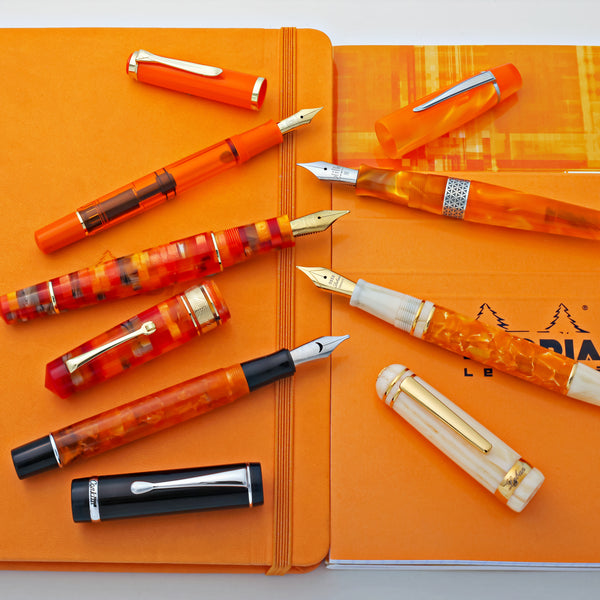In the magical realm of fountain pens, the majority of nibs write with an unchanging line width. What is a flex nib? Flexible fountain pen nibs provide line variation in the tradition of steel-nibbed calligraphy dip pens. Add calligraphic flair to your handwriting using a variety of unique fountain pens. In this post and video below, we go over the various options of flex nib fountain pens in all price ranges, summarizing the pros and cons of each. Then, we show you how to get started with your new pen, what types of ink to use, and how to practice safe flex. Read on to the end to enter our giveaway for a chance to win your own flex nib fountain pen!
Guide to Writing with a Flex Nib Fountain Pen
If you have no clue what a flex nib is and how it differs from a standard fountain pen nib, check out the "stub vs. flex nib" video to get caught up.
When searching for a flex nib pen, there aren't many options and the really good ones tend to be rather expensive. So, when someone asks, "what's a good starter flex nib," it's a question that has a highly nuanced answer. To help clarify, let's look at the various flex nib options from least expensive to most expensive.
Flex Fountain Pens Under $50
Monteverde Monza Flex Fountain Pens
Fountain Pen Revolution Flex Fountain Pens
Noodler's Ahab / Konrad Flex Fountain Pens
At under $50 you have pens like the Monteverde Monza Flex, the Noodler's Ahab or Konrad models, and the Fountain Pen Revolution flex nib. At this price level, the nibs are made of steel and are harder to press, giving a stingy amount of line variation and often needing tinkering to maintain consistent ink flow. As a kicker, the Noodler's and FPR pens are made from materials that tend to have an unpleasant odor. So, why do people go for these pens? They are the least expensive options that actually provide a somewhat flexible writing experience.
Flex Nib Fountain Pens $150 to $250
Pilot Falcon Fountain Pens
Pilot Custom 912 Fountain Pen with FA Nib
Desiderata Precession with Zebra G-Nib (Coming soon!)
If you can spend between $150 to $250 on a flex nib, then you have access to such pens as the popular Pilot Falcon, Pilot Custom 912 FA, or a Desiderata fountain pen with a Zebra G-Nib installed. The Falcon and the Custom 912 have a 14k gold nib, which seems to be the ideal amount of gold content to be soft, yet springy.
The Zebra G-Nib is a nib that is known for its wicked flexibility. Pierre Miller from Desiderata Pens hand-crafts ebonite feeds for his custom pens to utilize the Zebra Gnib. The result is a flex nib that provides an insane amount of line variation. However, I should mention that the Zebra G-Nibs will corrode over time and need to replaced over weeks or months of use.
Flex Nib Fountain Pens $500 and up
Aurora 88 and Optima 14kt Flex Nib Fountain Pens
SCRIBO FEEL the Flex 14kt Nib Fountain Pens
At the luxury level, two Italian pen manufacturers champion the flex nib. Aurora's 14kt gold flex nib and ebonite feed can be found on the Optima and 88 piston-fill models. The SCRIBO "Feel the Flex" 14kt gold nib fountain pen is also piston-filling with an ebonite feeder system.
Vintage Flex Pens & Nib customization
Now, although we do not sell vintage pens, I would be remiss to not mention that a vintage flex nib may provide you with the most satisfying flex experience for the money. However, they are a bit trickier to find. You could opt to work through a vintage pen dealer or reputable collector, but the prices will likely be highest. You might find a great deal searching on eBay or using various pen buy & sell forums on reddit, instagram or fountain pen network. The risk is that you're at the mercy of the individual seller, who may not have faithfully represented the pen.
The last option would be to get the nib customized by a professional nibmeister. Skilled hands can take a highly adaptable #6 size Jowo nib and modify it for flexibility. This option is also quite costly, considering a 14kt gold nib can cost over $100 without the custom grind charge.
So, which flex pen do I go with?
The best course of action to take depends on two factors:
#1 budget - how much are you willing to invest in this writing experience?
#2 flexibility - how much flex you're looking for? A little bounce or full-on wet noodle?
If you're a fountain pen enthusiast that generally prefers inexpensive pens under $50, then I would suggest saving up for the mid-level Pilot Falcon or Custom 912 for your first flex nib. The experience is far more reliable and enjoyable than tinkering with the entry-level steel nibs.
To see a direct comparison of various flex nibs in action, check out our writer's showcase flex nib showdown that features a variety of pens we mentioned here.
Uninked Flex Nib Fountain Pen
So, let's assume you've taken the plunge on a flex nib fountain pen are looking to get started writing like a boss calligrapher. We'll get there! First, let's talk about inking the pen.
Here's a step-by-step process, assuming you're starting off with a brand new, uninked flex nib fountain pen.
1. Clean out the pen
Ink flow is of utmost importance to a flex nib pen. Flexing demands a higher flow of ink. Ensure optimal ink flow by making sure the nib and feed are clear of any residual manufacturing oils or ink from testing. Rinse the pen nib and feed with cool running water and dry off with a paper towel or let air dry.
2. Choose your ink wisely
A well-behaved fountain pen ink with a moderate or wet flow is ideal to keep up with flex writing. Examples would be Waterman, Taccia, Sailor, J. Herbin, and Robert Oster. For that reason, I would caution against using any supersaturated, sheeny or shimmery inks when filling your flex pen for the first time. Highly-saturated inks tend to write a bit drier and may lead to skipping or railroading in a flex pen.
3. Fill it up
Fill your flex pen to the fullest, you'll be using a lot more ink than with a standard writing nib. If you are using a cartridge/converter filling pen, opt to use the converter.
4. Ink the Friendly Paper
Select a fountain pen friendly paper to use with your flex nib fountain pen. When flexing the tines, ink is flowing at a higher rate that will cause feathering and bleedthrough on cheap, recycled paper. Clairefontaine, Rhodia, and Tomoe River are examples of paper that will hold up to liberal amounts of fountain pen ink.
5. Angle and Pace are Key
Hold the nib at an angle of approximately 45 degrees from the surface of the paper. Use this as a starting point to find the optimal angle to write with the pen while flexing the nib. If the pen is angled too high, the nib won't flex much. Too low and you'll hazard hitting the feed on the paper while you write. Start off slowly and make gentle strokes of the pen on paper. Pretend like you're petting a cat with the nib.
6. Pressure ONLY on the downstroke
Keep in mind that pressure should only be applied to the nib as it is being pulled on the downstroke. The tines should spread apart evenly, so make sure not to roll your hand as you flex.
7. Start Off Simple
Before scribbling out your favorite quotes and flourished signatures, practice basic movements that are commonly found in letterforms. Loops, humps, swirls and the like. This will help get a feel for how responsive the nib is, how much it can be flexed, and whether there is an issue with ink starvation.
8. Practicing Safe Flex
I advise against pushing the flex too far. Although a flex nib fountain pen nib is designed for such strenuous activity, there is still a point of no return where a nib can bend permanently out of shape. To practice flex nib writing, try copying your favorite quotes, passages from books or writing a pangram like "the quick brown fox..."
Troubleshooting Tips for Flex Nib Fountain Pens
Railroading, or ink starvation, occurs when a flex nib does not lay down the full stroke of ink when flexed. Instead, it only traces the outline of it, like railroad tracks.
Don't feel defeated if you hit an issue with railroading. This can be remedied with a few simple troubleshooting tips.
1. Prime the feed
If the nib is being a bit stingy after non-use for a few days, it may need to be primed to get flowing again. If you're writing with a cartridge/converter fountain pen, advance the converter piston to force more ink into the feed. Dipping the nib in a small cup of distilled water may also help get things flowing again.
2. Slow down
Even the best feeds have their limitations to how quickly they can channel the ink. Slow down on the flexed downstroke.
3. Ease up on the flex
Ink starvation might be a nib's way of telling you that it's not meant to be pressed that far.
4. Change the ink
Some inks just don't pair well with certain pens. Before giving up on the pen, change the ink as a variable and see if it still has flow problems with a different color. Like I mentioned previously, pick one that has a wet flow. Be sure to rinse the pen out completely while changing inks.
Questions on writing with a flex nib?
We hope that you enjoyed this primer on how to write with a flex nib fountain pen. If you have any questions or suggestions on flex nib writing, please put them in the comments below. Enter for a chance to win a Pilot Falcon 14kt Gold Nib Flex Fountain Pen using the giveaway form below!



